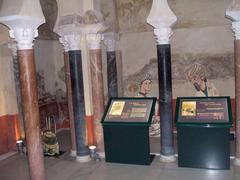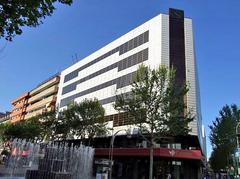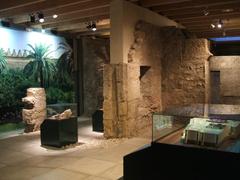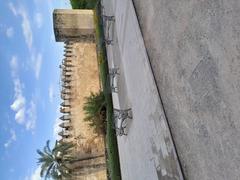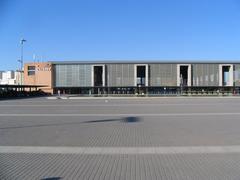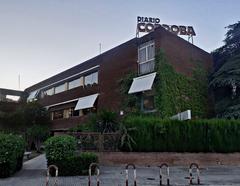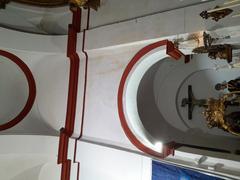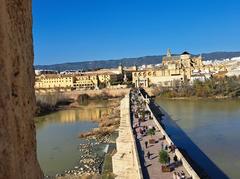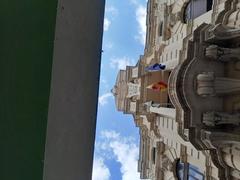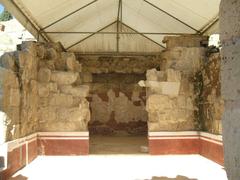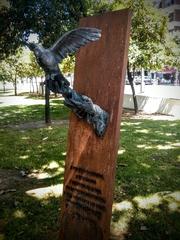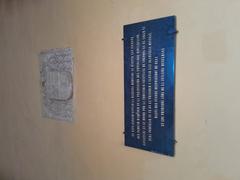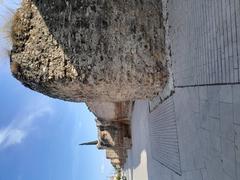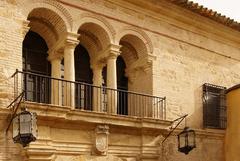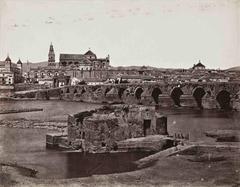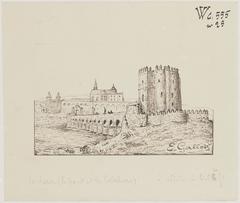Molino de San Rafael: Visiting Hours, Tickets, and Historical Significance in Córdoba
Date: 14/06/2025
Introduction
Nestled along the banks of the Guadalquivir River in Córdoba, Spain, the Molino de San Rafael stands as an enduring symbol of the city’s industrial and cultural heritage. Dating back to the late 16th century, this historic watermill offers a fascinating glimpse into Córdoba’s economic evolution and the ingenuity of Andalusian hydraulic engineering. Once instrumental in supporting the region’s agricultural output and adapting to industrial changes, the mill now serves as a monument to the city’s past—and an evocative riverside landmark for visitors. Although access to the interior is currently restricted due to its condition, the site remains an essential stop for those exploring Córdoba’s lesser-known historical treasures (Diario Córdoba; Artencordoba).
This guide provides a detailed overview of Molino de San Rafael’s history, architectural features, visiting logistics, nearby attractions, and practical travel tips—helping you make the most of your journey through Córdoba’s riverside heritage.
Table of Contents
- Introduction
- Historical Overview
- Architectural Features and Setting
- Visiting Molino de San Rafael
- Nearby Attractions and Travel Tips
- Heritage Status and Conservation Efforts
- FAQs
- Visual Gallery and Map
- Conclusion
- References
Historical Overview
Origins and Early Development
The Molino de San Rafael traces its origins to the late 16th century, first documented as the “Açuda que dizen de Salmerón” in 1575, under the management of the Salmerón family. Initially, the structure operated as hydraulic fulling mills (batanes) for wool processing, an industry vital to Córdoba’s pre-industrial economy. The site was later converted into a regolfo flour mill, utilizing the river’s current through a horizontal waterwheel and pozuelo (water chamber) for grain grinding. By the 18th century, it was known as Molino del Duende or Molino de Salmerón, reflecting shifts in function and ownership (Diario Córdoba).
Industrial Transformation and Decline
In the early 19th century, ownership passed to Lorenzo de Basabru, who briefly operated the mill as Córdoba’s only documented paper factory. By mid-century, it returned to flour milling, earning the moniker “Molino de las Siete Piedras” for its multiple millstones. Technological advancements and the rise of modern industry led to a gradual decline in the mill’s activity throughout the 20th century. The site changed hands several times, reflecting attempts to repurpose the building for hydroelectric generation—a transition that ultimately never reached full fruition (Explanders).
By the mid-20th century, Molino de San Rafael—like many historic mills along the Guadalquivir—fell into disuse, overtaken by vegetation and the passage of time.
Architectural Features and Setting
Molino de San Rafael is an outstanding example of 19th-century Andalusian industrial architecture. The building consists of three naves: a central square-plan nave with a sail vault, flanked by trapezoidal side naves with barrel vaults. The main grinding room once housed four millstones on a single bench. The lower level features a barrel vault allowing the river’s water to power the mill directly beneath the structure. These robust features reflect the adaptation of local materials—limestone, brick, and lime plaster—to the demands of riverine power and seasonal flooding (Artencordoba).
Physically connected to the neighboring Molino de San Lorenzo, the two form a twin-mill complex, partly concealed by the lush vegetation of the Sotos de la Albolafia, a protected natural area that enhances the site’s scenic appeal (Explanders).
Visiting Molino de San Rafael
Location and Access
Molino de San Rafael is situated on the east bank of the Guadalquivir River, just downstream from the San Rafael Bridge and within walking distance of Córdoba’s historic center. The riverside paths make for a pleasant stroll, offering views of the city’s skyline and the tranquil flow of the Guadalquivir (thecrazytourist.com).
Getting There:
- On foot: Easily accessible from the city center.
- Public transport: City buses have stops near the riverbanks.
- By car: Limited parking is available nearby, but walking or cycling is recommended for the full experience.
Visiting Hours and Tickets
Current Status: As of 2025, Molino de San Rafael is not open to interior public tours due to preservation concerns. There are no official visiting hours or ticket requirements; the site’s exterior can be enjoyed at any time from the adjacent riverside paths (turismodecordoba.org).
Guided Tours and Events:
While regular access to the interior is unavailable, local heritage organizations occasionally host guided tours or cultural events highlighting the site’s significance. For up-to-date opportunities, check with Córdoba’s tourism office or local cultural groups (Nomads Travel Guide).
Accessibility
The riverside paths near Molino de San Rafael are generally flat and accessible, but the immediate surroundings of the mill may have uneven terrain and are not suitable for wheelchairs. Visitors with limited mobility are advised to plan accordingly.
Nearby Attractions and Travel Tips
Combine your visit with other historical sites nearby:
- Molino de San Lorenzo: Adjacent to San Rafael, also visible from the riverside walk.
- Molino de Martos: Now a hydrology museum.
- Molino de la Alegría: Home to the Museum of Paleobotany.
- Alcázar de los Reyes Cristianos: A major Córdoba landmark just upriver.
- Roman Bridge and Mezquita-Catedral: Easily reached on foot via scenic paths.
Visitor Tips:
- Visit early morning or late afternoon for the best light and pleasant temperatures.
- Bring comfortable shoes and water.
- Respect the site’s fragile state—do not climb structures or remove stones.
- Check local event calendars for special mill-related festivals or exhibitions (andalusian-adventure.com).
Heritage Status and Conservation Efforts
In 2009, Molino de San Rafael and its neighboring mills were declared part of the Andalusian Historical Heritage, recognizing their importance to Córdoba’s industrial and architectural legacy. While restoration is ongoing, the site remains largely in its original, ruinous state. Local authorities and heritage groups continue to advocate for its preservation and promote awareness of its significance (Explanders).
Frequently Asked Questions (FAQ)
Q: Can I buy tickets or enter Molino de San Rafael?
A: No, there are no tickets or interior visits currently available. The site can be admired from the exterior at any time.
Q: What are the visiting hours?
A: The area is open to the public year-round for exterior viewing; there are no set hours.
Q: Is the site accessible for people with disabilities?
A: The surrounding paths are mostly accessible, but close access to the mill itself may be difficult due to uneven ground.
Q: Are guided tours available?
A: Occasionally, local organizations offer special tours. Check with Córdoba’s tourism office for current offerings.
Q: What else can I see nearby?
A: Explore adjacent historic mills, the Alcázar, the Roman Bridge, and the Mezquita-Catedral.
Visual Gallery and Interactive Map
Image: Exterior view of Molino de San Rafael, Córdoba
Alt text: Exterior view of Molino De San Rafael, a historic mill in Córdoba
Image: Traditional millstones inside Molino de San Rafael
Alt text: Traditional millstones and wooden gears inside Molino De San Rafael
Interactive map of Córdoba historical sites including Molino De San Rafael
Conclusion
Molino de San Rafael stands as a poignant reminder of Córdoba’s industrious past and the enduring relationship between the city and its river. Despite its current ruinous state, the mill invites visitors to reflect on the technological and social advancements that shaped Andalusia. Whether you’re walking the riverside paths, exploring nearby landmarks, or attending a special heritage event, the site offers a unique perspective on Córdoba’s layered history.
For the most current information on events, restoration updates, and guided tours, download the Audiala app and follow local tourism resources. By supporting and respecting sites like Molino de San Rafael, visitors contribute to the ongoing preservation of Córdoba’s rich and diverse heritage.
References
- Antiguos molinos de Córdoba, 2023, Diario Córdoba
- Los molinos del Guadalquivir, 2024, Artencordoba
- San Lorenzo and San Rafael Mills, 2023, Explanders
- Walking Tour of Córdoba, 2023, Nomads Travel Guide
- San Rafael Triumphs in Córdoba, 2023, tocordoba.com
- Things to do in Córdoba, 2023, Andalusian Adventure
- 15 Best Things to Do in Córdoba, 2023, The Crazy Tourist
- Triunfo de San Rafael, 2023, turismodecordoba.org
